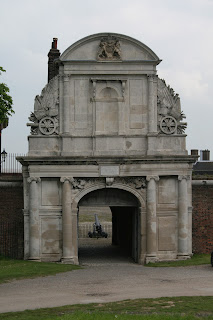A couple of Saturdays ago my five year old son and I had another "boys day out". As a special treat I took him for a visit to Tilbury Fort. For those unfamiliar with the local geography, the town of Tilbury, Essex lies on the opposite bank of the River Thames to Gravesend, Kent.
We joke that while other towns in Kent have twinning arrangements with towns on the Continent, in Gravesend we have a mutual suicide pact with Tilbury.
The two towns have been linked by a ferry service for centuries. As well as it being my son's first visit to Tilbury it was also his first time afloat, albeit for only a very short time - the ferry crossing only lasts about five minutes.
The current ferry operating the service is the "Duchess M" built in 1956. Up until the opening of the Dartford Tunnel in the 1960's car ferries operated the service but now it's foot passengers and bikes only.
Looking back at the Gravesend river front.The passenger vessel alongside the pier is the "Princess Pocahontas". She operates pleasure cruises on the Thames.
The ferry berths on Tilbury Landing Stage. The 1142' long Landing Stage was designed by Sir Edwin Cooper to accommodate large passenger liners and was opened by Prime Minister Ramsay Macdonald on 16th May 1930.
On the same day the P&O vessel Mongolia called to embark passengers for Australia. Subsequently many thousands of passengers transited through Tilbury on their way to the Antipodes and other corners of the Empire. Another famous vessel to call at the Landing Stage was the Empire Windrush which brought some of the first migrants from the Caribbean in 1948.
From the Landing Stage we had a short walk along the river bank to Tilbury Fort passing by the appropriately named Worlds End pub. The river bank is very popular with anglers but nobody seemed to have had much luck as we passed by.
The shipping passes close to shore. The Hong Kong registered tanker "MTM Singapore" was inward bound from the USA.
The Fort, according to English Heritage, is one of the finest surviving 17th century forts in England.
Construction was started in 1672 during the reign of King Charles II on the site of an earlier Tudor fortification. It was built to defend London from attack by the Dutch who had mounted a daring raid up the River Medway a few years previously (more about this in a later post...). The impressive Water Gate pictured above serves as the main entrance to the Fort.
The Guard house which doubles as the ticket office and gift shop
My son explaining the finer points of 17th century artillery operations!
The officer's barracks and water pump in the parade ground. Some of the buildings are used as residences by the English Heritage staff and their families. One of the buildings contains a museum of World War I and II weapons, uniforms etc.
My son was looking at the World War II gas masks and asked me if I used to wear one - cheeky sod!
The Fort was surrounded by moats as an extra defence.
The business end. Throughout it's history the Fort was regularly re-equipped with more modern guns. The last guns were installed in 1902. However, by this time the Fort was becoming obsolete due to advances in naval technology.
During World War I the Fort was used as an assembly point for Allied troops en-route to France and as a supply depot. It remained under military control until the 1950's.
Heading back to the ferry the "Maersk Nairobi" passed inward bound from Mexico and Central America whilst the 93000 tonne "Santa Teresa" left London headed for Brazil.
I'm not tired Daddy. I'm just sunbathing.....
Gravesend Town Pier opened in 1834 is the oldest surviving cast iron pier in the world. It now houses the Riva restaurant and bar.
St George's church - another Gravesend landmark. We could hear the church bells across the river in Tilbury.
Well we had been to the dark side!
If you have enjoyed reading this post you may also like...
Long John Silver Cumbers
Porcupines and Masons
Admiral Sir Cloudesley Shovell






















The officer's barracks at the fort were beautifully designed. The ordinary ranks may have had to live in squalour but the officers (and you note some of the English Heritage staff and their families) lived well.
ReplyDeleteI am glad that one of the buildings is used as a WW1 museum. I am not interested in the weapons, but I would like my children to know about ordinary soldiers, their families and their sacrifice.
Hello and greetings from Montreal, Canada. My father's parents were born in Kent. I have never had the opportunity to visit overseas as yet, but I am very happy to have found your blog with information about Kent. Thank you so much for sharing.
ReplyDeleteHi Glen
ReplyDeletedid you see the large tugs steaming stern-first up the Thames?I asked an RN Officer why this might be ,and he was unable to shed any light.
GP.
Hi Linda - many thanks for your kind comment. Hope you make it to Kent one day.
ReplyDeleteGP - The modern tugs steam astern to reduce the wash effect (they have quite a deep draft for their size)
Glen
I was on the ferry a few times when I visited Kent with my bike. On one occasion I did not have any change and offered the ferryman a Scottish 10.00 note. Fortunately he took it.
ReplyDeleteI was in the Edinburgh area a few weeks ago and the Firth of Forth was the most heavily defended estuary area during the World Wars.
On the causeway to the island of Cramond there are concrete blocks which were put in place to stop German submarines.
Hi Jane, thanks for your comment.
ReplyDeleteGlen